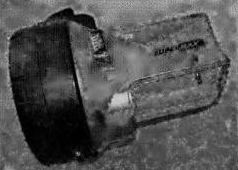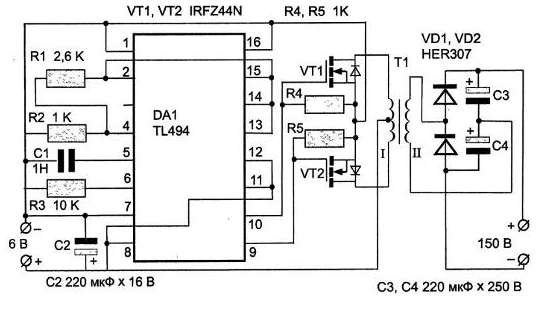
|
|
ENCYCLOPEDIA OF RADIO ELECTRONICS AND ELECTRICAL ENGINEERING Voltage converter for portable flashlight. Encyclopedia of radio electronics and electrical engineering
Encyclopedia of radio electronics and electrical engineering / Voltage converters, rectifiers, inverters On occasion, I bought a portable LED flashlight (made in China) with a battery inside and with the ability to turn on an incandescent lamp (the ability to switch between a cluster of 8 super-bright LEDs and a 5,4 V krypton lamp). There is also a battery charger inside. In addition, the lamp is combined with a lamp with a 6 W fluorescent lamp, powered by a special voltage converter 6 ... 150 V.
The appearance of a multi-purpose lamp Backlighting with an energy-saving lamp (hereinafter referred to as EL) of the Osram Dulux S7W type, implemented in this design, is very convenient for many purposes. With it, you can read in a tent, on a camping trip, in field conditions continuously for 6 hours - due to the low power consumption of the lamp, provided that the built-in battery is fully charged. I tested the lantern and its lamp with an energy-saving lamp "for strength" in the countryside throughout the year. It seems to me that the circuit design of the voltage converter is very successful and valuable for repetition in other designs, and for using the finished converter board for powering EL with a power of up to 8 W - in an aquarium lamp.
Electrical diagram of the device Principle of operation of the device A device implemented according to the scheme of a push-pull pulse voltage converter operates at a frequency of approximately 112 kHz. At the heart of the circuit, the TL494 chip is a ready-made pulse-width modulator of signals, so the circuit and the device as a whole are very simple. At the output of the circuit, high-voltage rectifier diodes are installed that double the converted voltage. In the converter, as T1, a ready-made high-frequency transformer of the brand from the power supply unit of the "outdated" Canon BJC-2000 printer, brand EL33-ASH is used. After measuring the resistance of the windings relative to each other, it is clear that their ratio (I to II) is 1:20. The tap in the primary winding is made exactly from its middle (that is, the primary winding in this case consists of two halves). Since I have accumulated several such transformers of the EL33-ASH type from old PSU printers, I disassembled one of them, and I can state that its secondary winding consists of 220 turns of wire with a diameter of 0,3 mm. Fixed resistors R1 and R2 set the pulse width at the converter output. The circuit can be simplified and do not use R1, R2, while the 4th output of DA1 must be connected to a common wire (minus power). Resistor R3 (together with capacitor C1) sets the operating frequency. It can be adjusted to a small extent. When the resistance of the resistor R1 decreases, the frequency of the converter generator increases. With an increase in the capacitance of the capacitor C1, the frequency decreases, and vice versa. About details Chip TL4 94 can be replaced by 1114EU4; it is a complete analogue. Powerful MOSFETs VT1, VT2 are characterized by short switching time and simple control circuit. They can be replaced by IRFZ44N, IRFZ46N, IRFZ48N (the larger the number in the marking, the more powerful the analogue). Instead of HER307 rectifier pulse diodes, HER304-HER306 or KD213 with any letter index are suitable. Oxide high-voltage capacitors C3 and C4 - with an operating voltage of at least 200 V, type KX, CapXon, HCY CD11GH, ASH-ELB043. The converter is powered by a portable battery with a voltage of 6 V and a capacity of 1,2 Ah. Protection of the circuit from overload and reverse power-up (when using the finished board in other designs) can be implemented through a fuse and a diode connected in the forward direction at the input. The output, as can be seen from the diagram, is distinguished by a high potential difference; and it is not shunted by a resistor. Therefore, when connecting the circuit, its operation, I recommend that you observe safety measures, since the high-voltage voltage charge is maintained for one day. Do not turn on this converter without load - EL lamps.
Portable battery Other applications EL controlled by the considered converter can be used for local illumination of a garage, an aquarium, a car interior, and in many similar cases. Author: Shelestov I.P.
Machine for thinning flowers in gardens
02.05.2024 Advanced Infrared Microscope
02.05.2024 Air trap for insects
01.05.2024
▪ Flying racing electric car Alauda Airspeeder Mk3 ▪ Control of phonons with photons of light ▪ Sony IMX183CLK-J and IMX183CQJ-J image sensors ▪ Liquid crystals for tumor diagnostics
▪ section of the site Electrician in the house. Article selection ▪ article Powder rocket engine. Tips for a modeler ▪ article Can water conduct sound? Detailed answer ▪ article Loader. Job description ▪ article Multiplying stress. Encyclopedia of radio electronics and electrical engineering
Comments on the article: Edward Well, let's say that there is a converter for powering a fluorescent lamp, but it is made with only 1 transistor transformer and a couple of elements (there are no microcircuits there). a couple of hours at the most
Home page | Library | Articles | Website map | Site Reviews www.diagram.com.ua |






 Arabic
Arabic Bengali
Bengali Chinese
Chinese English
English French
French German
German Hebrew
Hebrew Hindi
Hindi Italian
Italian Japanese
Japanese Korean
Korean Malay
Malay Polish
Polish Portuguese
Portuguese Spanish
Spanish Turkish
Turkish Ukrainian
Ukrainian Vietnamese
Vietnamese



 Leave your comment on this article:
Leave your comment on this article: